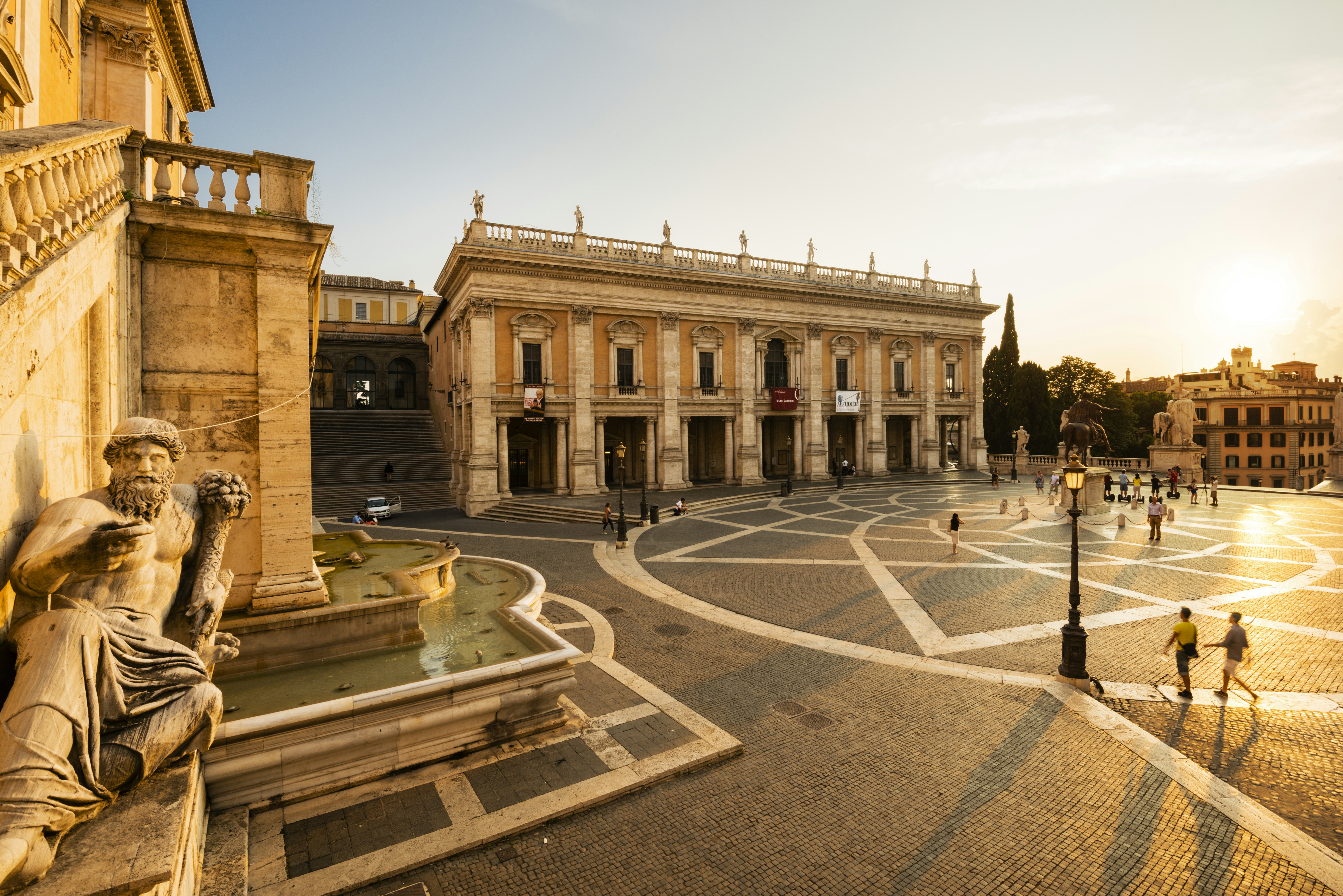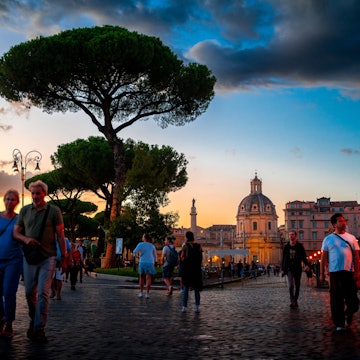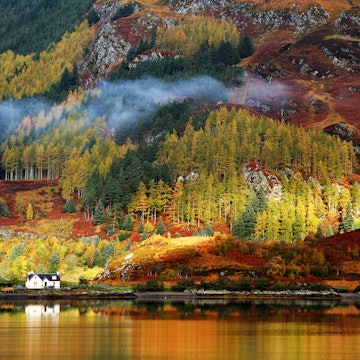
The 24 best free things to do in Rome



Rome, Italy. renbrins / Shutterstock
Rome is a city where the doors of art-laden churches are flung open to all, ancient architectural wonders await around many corners and it costs nothing to roam the historic streets, piazzas and parks. There are countless free sights, and many ticketed attractions can be accessed for free if you plan ahead.
Here are 24 of the best free things to do in Rome.


1. Enjoy a stroll through history
Rome is the very definition of an open-air museum: you can see hundreds of attractions without paying for a single entry ticket simply by walking past and enjoying them from street level. You can admire the awe-inspiring exteriors of the Colosseum, Pantheon, Circo Massimo or the Vittoriano as you stroll through the city center on your way from historic places such as Campo de’ Fiori, Piazza Navona or the Roman Forum.

2. See famous religious art in Rome’s churches
You can see many of Italy’s most famous works of art not in museums but in churches, which are free to enter. Admire Michelangelo’s Piety in St. Peter’s Basilica, Caravaggio’s The Calling of St. Matthew in Chiesa di San Luigi dei Francesi and Bernini’s Ecstasy of St. Theresa in Chiesa di Santa Maria della Vittoria, just to name a few masterpieces. Rome has more than 900 churches, almost all of which are adorned with sculptures and frescoes; if you appreciate religious art, walk into any church to be awed. You might stumble upon a world-famous masterpiece you didn’t know was there.
3. Drink unlimited clean water from historic fountains
You never need to buy water when in Rome; the city has more than 2500 public fountains dispensing clean drinking water. Many fountains – called nasoni (“big noses”) – were installed in the 1870s when Rome became the capital of unified Italy, but plenty more have been installed since. The most recent ones look different from the classic nasoni and even allow you to choose between sparkling and still water. Purchasing water bottles in Rome can be expensive; cut this expense by bringing your reusable water bottle and filling it at every nasone you see – it’s a quintessential Roman experience.
Local tip: Do not crouch to drink from the nasone. Rather, place a finger in the tube, and the pressure will make the water come out of a smaller hole on top of the faucet, so you can drink much more comfortably.
4. Enjoy free museums in Rome
Rome has more than two hundred museums and while many of them are ticketed, some are always free to all. The list of free museums in Rome includes Museo Giovanni Barracco, (where you can admire hundreds of sculptures from Egyptian to Greek to Roman art in a 16th-century building a stone’s throw away from Piazza Navona), the Napoleonic Museum, and the Villa di Massenzio, among others.


5. Enter ticketed museums for free
More than 30 museums and attractions are free every first Sunday, including the Colosseum, the Archaeological Park of Ostia Antica, and the Vittoriano. (The Vatican Museums are free on the last Sunday of every month.) While this means these places will be more crowded, it also allows Romans and tourists alike to dedicate an entire day to culture and museum-hopping.
If you can’t take advantage of free Sunday admission, check each museum’s ticket information to see if you can get a discount; you may be eligible based on your age, profession or nationality. Minors often get in for free or at a discounted price, as do students and teachers from the European Union and senior citizens.
Planning tip: If you are a student of any nationality, show your student ID and you may get a discount even if you technically do not qualify for one.
6. Go to an outdoor movie screening
Every summer, the nonprofit association Piccolo America organizes a series of free movie screenings in various locations throughout Rome called Il Cinema In Piazza (“cinema in the square”). Films vary each night – cartoons, classic Hollywood films, international Oscar winners and to recent releases – all shown in their original languages with Italian or English subtitles. If you are in the mood for a movie, go out and share the free experience of watching a film in a picturesque setting with hundreds of Romans and tourists.
Planning tip: Screenings typically begin at dinner time. Scout the area before then and split up – someone to hold seats and someone to grab local street food like supplì (battered and fried risotto shaped into cylinders and filled with cheese).

7. Admire street art in Rome’s hip neighborhoods
Everywhere you turn in Rome there is a Baroque church, an outstanding fountain or a 2000-year-old building waiting to wow you. For millennia, the architects and artists of the city have made an effort to leave a lasting impression.
The same can be said of contemporary Roman and international artists who contribute to making the city more colorful with their street art. Head a bit off the beaten path and tour some of the most iconic murals of the city in the Ostiense, Testaccio and Pigneto neighborhoods.
8. Visit Rome’s incredible rose garden
The Roseto Comunale on the Aventine Hill is home to more than 1000 species of roses. Every spring, you can visit it for free; the dates may vary, so it’s always best to check the calendar on an official Roma Capitale page. Reservations are not needed unless you’d like to arrange a guided tour. Take a break from the chaos of sightseeing and simply enjoy this corner of colorful nature in the heart of Rome.


9. Have a picnic in Villa Doria Pamphilj
An iconic and picturesque park in the Monteverde neighborhood, Villa Doria Pamphilj is a prime spot for picnics, study dates and impromptu ball games for people of all ages. The massive park measures 180 hectares and presents different types of scenery, including a view of the imposing 17th-century palace within the park. Whether you are looking for shade in summer or sunlight in spring, fall or winter, Villa Pamphilj is ideal for a break from traffic.
10. Admire the riches of St Peter's Basilica
There will probably be a line to get into the showstopping St Peter's Basilica. It took 126 years to build, so a little wait to see this opus maybe isn't so bad. As Rome's largest, richest and most spectacular basilica, St Peter's leaves all other churches in its shadow – and is completely free to enter. The basilica is home to three of Italy’s most celebrated masterpieces: Michelangelo’s Pieta, his soaring dome and Bernini’s 29m-high (95ft) baldachin over the papal altar.
Planning tip: If you don’t want to wait in line, you can book a €7 (US$8) audio tour of the basilica along with a time slot to enter. You’lll need to book a ticket to climb the dome.

11. Soak up local life on the Piazza Navona
Long a hub of local life in Rome, Piazza Navona hosted Rome’s main market for nearly 300 years. Now there is a Christmas market during the holiday season and plenty of activity year-round.
Come in the early morning before the crowds or after dark when fountains, like Bernini’s iconic Fontana dei Quattro Fiumi, are illuminated to enjoy Piazza Navona at its most alluring. Or better yet, be there when it’s crowded to watch the street performers and tourists come and go and hang out until dusk.


12. Wander the paths of Villa Borghese
Locals, lovers, tourists, joggers – no one can resist the lure of Rome's most famous park. Villa Borghese is an oasis of shaded walkways, verdant corners and excellent museums to be explored. The lovingly landscaped Giardino del Lago features a copy of a Roman temple on the lake’s artificial islet.
Planning tip: For panoramic views of St Peter's Basilica, walk up Pincio Hill and head for the terrace.

13. Pay tribute in the Jewish Ghetto
The atmospheric Jewish Ghetto is studded with artisans' studios, kosher bakeries and popular trattorias. Dating back to the 2nd century BCE, this is one of the oldest Jewish quarters in Europe. While some Jewish people came as business envoys, most came as enslaved people.
As you stroll around, look for a series of brass cobblestones. These are memorial plaques commemorating the city’s Holocaust victims: each one names a person and gives the date and destination of their deportation and death. They are placed outside the victims’ homes.

14. Explore the Via Appia Antica
Antiquity's most famous road, Via Appia Antica, has been an exclusive Rome address since 312 BCE. The most pleasant way to on foot, making it perfect for a free experience. The Via Appia Antica is a beautiful cobbled thoroughfare flanked by grassy fields, Roman structures and towering pine trees. It was here that Spartacus and 6000 of his enslaved rebels were crucified and early Christians buried their dead.
Planning tip: For more information and a map of the area, stop by the Appia Antica Service Center at the northern end of the road.

15. Find peace in Cimitero Acattolico
A verdant oasis of peace, Rome’s "non-Catholic" cemetery in the southern neighborhood of Testaccio is imbued with a kind of Grand Tour romance. Up to 4000 people are buried here, including poets John Keats and Percy Bysshe Shelley.
As you wander among the gravestones, look for the Angelo del Dolore (Angel of Grief), an oft-replicated 1894 sculpture that US artist William Wetmore Story created for his wife’s grave.


16. Browse the market at Campo de' Fiori
Colorful and always busy, Campo de' Fiori is a major focus of Roman life: by day, it hosts one of the city's best-known markets, and by night its bars and restaurants do a brisk trade. The piazza's poetic name (Field of Flowers) refers to the open meadow that stood here before the square was laid out in the mid-15th century.

17. Marvel at Renaissance architecture at Tempietto del Bramante
Bramante's tempietto (little temple) is considered the first great building of the High Renaissance. It is a perfect little surprise squeezed into the courtyard of the Chiesa di San Pietro in Montorio, on the spot where St Peter is said to have been crucified. Its classically inspired design and ideal proportions epitomize the Renaissance zeitgeist.
Planning tip: It's quite a climb up to the church, but it makes an ideal stop on a walking tour of Gianicolo. The tempietto is reached through the Spanish Royal Academy entrance to the north of the church. If you can get access to the academy’s upper level, you'll find magnificent views of Rome.
18. Find the hidden square through Arco degli Acetari
For one of Rome’s most picturesque scenes, head to this dark archway just off Campo de’ Fiori. The arch itself isn’t especially memorable, but go through it and you’ll emerge onto a tiny medieval square enclosed by rust-orange houses and cascading plants. Cats and bicycles litter the cobbles while washing hangs off pretty flower-lined balconies overhead.

19. Head up to hilltop Piazza del Campidoglio
This hilltop piazza, designed by Michelangelo in 1538, is one of Rome's most beautiful squares. There are several approaches to Piazza del Campidoglio, but the most dramatic is the graceful Cordonata staircase, which leads up from Piazza d'Aracoeli.
20. Learn about legends in Basilica di San Pietro in Vincoli
This 5th-century church was built to house the shackles of St Peter, which are displayed under the altar. But the real star of the show at Basilica di San Pietro in Vincoli is Michelangelo's muscular sculpture of Moses with horns, which has its own interesting legend debating whether the horns resulted from a mistranslation of original Hebrew text or were included by Michelangelo as some sort of protest.
Planning tip: The church is accessed via a steep flight of steps leading up from Via Cavour and passing under a low arch.

21. Peer into Villa del Priorato di Malta
You probably can’t go inside the Villa del Priorato di Malta, but head over to the Sovereign Order of Malta anyway and peek through the keyhole. You'll see one of Rome’s most celebrated views: St Peter's dome, perfectly framed at the end of a hedge-lined avenue.
22. Partake in the passeggiata
The passeggiata (traditional evening stroll) is a quintessential Roman experience. It's particularly colorful on the weekends, when families, friends and lovers take to the streets to strut up and down, slurp on gelato and window-shop.
Planning tip: To join in, head to Via del Corso around 6pm. Alternatively, watch the theatrics on Piazza di Spagna.

23. See atmospheric architecture in Quartiere Coppedè
One of Rome’s most extraordinary neighborhoods, Quartiere Coppedè was conceived and built by the little-known Florentine architect Gino Coppedè between 1913 and 1926. It's a fairy-tale series of palazzos with Tuscan turrets, Liberty sculptures, Moorish arches, Gothic gargoyles, frescoed facades and palm-fringed gardens, centering around the magnificent Piazza Mincio.
24. Visit the landmark Trajan's Column
The ancient landmark of Trajan's Column towers over the Imperial Forums. If you can make them out, the reliefs depict Trajan's military campaigns in great detail.














